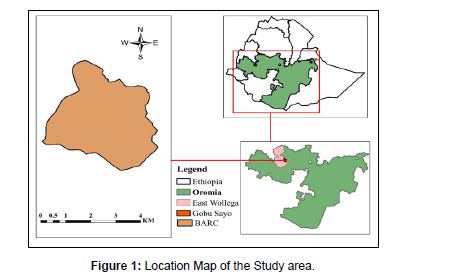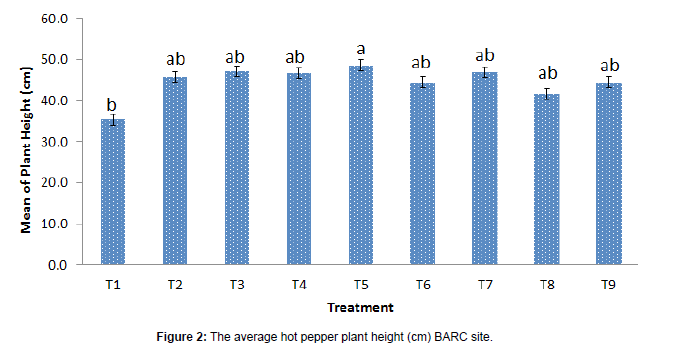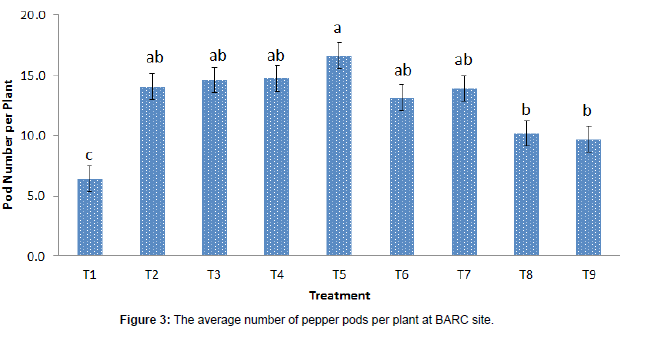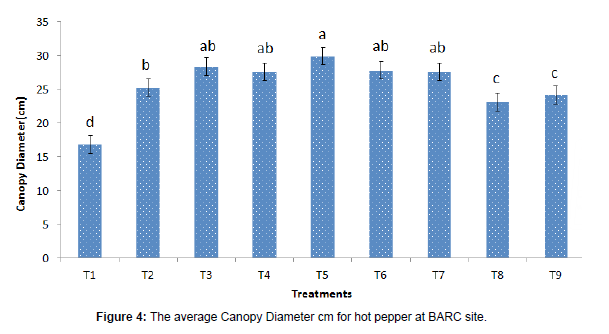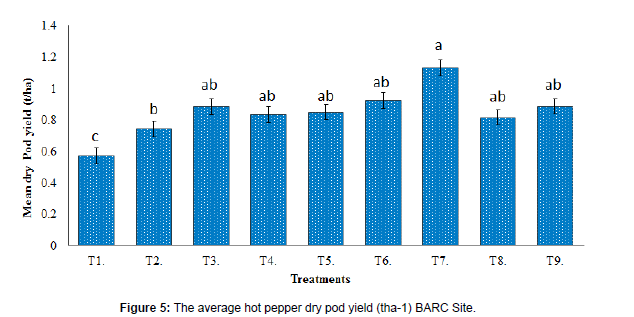Evaluation of Organic and Inorganic Amendments for Suppressing Soil Acidity and Enhancing Soil Fertility for Hot Pepper (Capsicum annuum L.) in the Acidic Soil of Bako, Western Oromia, Ethiopia
Received: 03-Nov-2023 / Manuscript No. Jbrbd-23-119794 / Editor assigned: 05-Nov-2023 / PreQC No. Jbrbd-23-119794(PQ) / Reviewed: 19-Nov-2023 / QC No. Jbrbd-23-119794 / Revised: 24-Nov-2023 / Manuscript No. Jbrbd-23-119794(R) / Published Date: 30-Nov-2023
Abstract
Understanding the impact of organic and inorganic components on soil fertility and quality is critical to improving low-yielding soils. Field trials were conducted for five consecutive main growing seasons (2016-2020) for hot pepper at the Bako Agricultural Research Center, Western Oromia, Ethiopia. The aim is to determine the long-term effects of organic and inorganic fertilizers on soil physical and chemical properties, plant nutrient availability and crop productivity to achieve sustainable agricultural development. Furthermore, the performance of organic materials is compared with that of inorganic materials and their combined effect in mitigating aluminium toxicity in acidic soils is examined. Treatments (NPS, farmyard manure (FYM) and lime) were combined to evaluate their effects on crop yields and soil fertility dynamics. Treatments were designed in RCBD with each plot measuring 2.8m x 2.4m in 3 replicates. The field layout and fine seedbeds are prepared as designed. FYM and lime were applied at three different levels. For pepper, 0, 1.05 tha-1, 2.1 tha-1 lime, 0, 5 tha-1, 10 tha-1 FYM and 0, 50 kgha-1, 100 kgha-1 NPS were applied. At the beginning of the experiment (2016), lime was added to the soil of the treated plots one month before sowing to buffer the soil, and a full dose of FYM was applied once during the first year according to its levels during planting. Then, apply NPS year after year until the experiment is terminated. Hot Pepper of Bako Local variety was planted on the BARC site and significant differences were observed between treatments. As a result, the treatment combination (1.05 tha-1 lime + 10 tha-1 FYM and 100 kgha-1NPS) obtained the highest combined average dry pod yield (1.13 tha-1), while the control treatment obtained the lowest average dry pod yield (tha-1). Ultimately, the collected and analyzed post-harvest soil parameters showed progressive changes in soil physical and chemical properties over successive years compared to composite soil samples collected before sowing at the start of the experiment (2016). Partial budget analysis shows that integrated application of NPS, FYM and lime is feasible in hot pepper production in the study area.
Keywords
FYM; Lime; NPS, Hot pepper; Soil dynamics; Yield
Introduction
Ethiopia's economy is based on agriculture, which generates 90% of the nation's export revenue and 46% of its GDP and employs 85% of its workforce (Lobamo, 2020; Moreda, 2020). Increasing agricultural production is very important in order to feed the expanding population by improving land productivity (De Boer and van Ittersum, 2018). A global objective, ensuring enough agricultural yields while preserving soil health and sustainable agriculture presents unique difficulties in specific climate-sensitive areas. Unfortunately, soil has low organic matter content and nutrient availability, resulting in low crop productivity (Liu et al., 2017). Most Ethiopian soils have low nutrient content due to erosion and lack of nutrient recycling. Since then, declining soil fertility has become one of the most challenging and limiting factors for food security in the region. Increasing demands on food supply or security in the region require improved soil quality to increase crop yields (Spiertz, 2013). Ethiopia has huge agricultural potential due to its fertile land, diverse climate, generally sufficient rainfall, and abundant labor force [1]. However, despite this potential, Ethiopia's agriculture remains underdeveloped.
Much of sub-Saharan Africa, including Ethiopia, is now characterized by poor soil and crop health and poor water quality, leading to human malnutrition and low levels of economic development (Adeyeye et al., 2023). Overall, improving crop yields and productivity is a critical issue in order to feed the country's alarmingly growing population; even though soil fertility is declining in many parts of sub- Saharan Africa (SSA), warranting intervention. Due to limited fertilizer application in Ethiopia, soil fertility depletion is one of the major obstacles to continued crop productivity. Soil organic matter (SOM) is critical to soil function and quality. Thus, soil carbon (C) sequestration in agricultural soils has been suggested as a strategy to improve soil quality improving soil physical and chemical properties by increasing soil organic carbon (SOC) has been proposed to increase crop yields [2].
One of the major constraints to crop production faced by smallholder subsistence farmers is inadequate supply of nutrients; erosion and severe run-off are further depleting existing soil nutrient reserves, while levels of soil organic matter are declining as land is subject to over-use [3]. Soil is a non-renewable or finite resource and is the bank of nutrients for plant growth. Most soils in the tropical region including Ethiopia are highly weathered and infertile due to lower organic matter content and open nutrient cycling systems. These led to soil fertility depletion and crop productivity reduction in the country by different soil degradation agents. Crops yield can be enhanced through balanced application of fertilizers (inorganic and organic soil nutrients). However, the unaffordability of fertilizers and lime, and unsustainable crop production calls for use of locally available low cost organic sources through manures, green manures, and mineral fertilizers in a harmonized combination for sustainable production and soil quality [4].
Soil acidity is a critical issue requiring urgent attention in most highlands of Ethiopia as it affects crop production and productivity. As a result, acidic soils limit crop yields in many developing countries where food production is critical. Acidic soils are phytotoxic due to nutritional imbalances and deficiencies of essential nutrients such as calcium, magnesium, molybdenum, and phosphorus, as well as the toxicity of aluminum, manganese, and hydrogen activity In Ethiopia, large areas of land in the western, southern and even central highlands of the country are thought to be affected by soil acidity due to high rainfall. The increasing trends in soil acidity and exchangeable Al3+ in cultivated and wasteland soils have been attributed to intensive farming and the continued use of acidic inorganic fertilizers Thus, soil acidity is a critical issue requiring urgent attention in most of Ethiopia's highlands as it affects crop yields and productivity. The application of organic and inorganic amendments can effectively reduce problems and improve soil fertility levels. Several measures have been suggested to recycle acidity and increase the productivity of highly acidic soils. For instance, fertilizers alone can only provide one or two nutrients to crops. On the other hand, providing only organic inputs improves the soil physical and biological environment but has the disadvantage of low plant nutrient content. Liming the soil increases soil pH while reducing soil acidity, thereby increasing nutrient availability for crop growth Research has been conducted on combining inorganic fertilizers and organic soil amendments to maintain soil health and achieve higher crop yields. Studies have shown that organic/inorganic amendments (fertilizers) can significantly increase the abundance, diversity and composition of soil microbial communities where bacteria are significantly affected by the type of amendment/fertilizer, while fungi are only affected by specific amounts Although all these mentioned organic and inorganic amendments contribute significantly to reducing soil acidity, improving soil fertility and nutrient transfer, Ethiopian highlands agriculture is characterized by poor agricultural productivity compared to developed countries due to declining soil fertility over the years, and inadequate applications of amendments. However, in today's era, agriculture is not only about production but also takes into account the sustainability of all resources, including soil, and the integration of nutrients for future generations is a key issue [5]. The amount and timing of application of lime, manure, compost and inorganic fertilizers to soils alone or in combination and the chemical effects observed have not been adequately studied in various regions of Ethiopia. Degradation of soil and water resources due to the use of chemical fertilizers has been reported many times.
Hot Pepper is the second most important vegetable in the world after tomatoes and belongs to the Solanaceae family. It is the most produced food flavoring, condiment and color while providing essential vitamins and minerals. Hot peppers are widely grown in a variety of environmental and climatic conditions. In Ethiopia, hot peppers are grown in many parts of the country and are an important source of income for smallholder producers. Growing peppers requires well-drained soil rich in organic matter. This is due to the fact that this plant is highly sensitive to choked roots and adapts well to a pH range between 5.5 and 7. Several researchers reported that utilizing vermin compost can enhance the growth of peppers and enrich soil amendments, providing highly nutritious organic fertilizers and more powerful growth promoters compared to conventional fertilizers. By using a combination of organic and inorganic amendments to improve soil fertility and acidity management, applied inputs can be efficiently utilized and agricultural productivity increased. Therefore, this experiment was conducted to study the long-term effects of organic and inorganic fertilizers on soil physicochemical properties, plant nutrient availability, and pepper productivity for sustainable agricultural development, and to examine their combined effects in mitigating aluminum toxicity.
Materials and Methods
Description of the study area
The experiment was conducted on hot pepper at the Bako Agricultural Research Center (BARC) for five consecutive years (2016- 2020). BARC is located at latitude of 90 6’N and longitude of 370 9’E and 1650m above sea level. BARC is located 250 kilometres west of Addis Ababa, with a warm and humid climate, with average annual minimum and maximum temperatures of of 13.5 and 29.7 0c, respectively. The total annual rainfall at this location is 1316.74 mm (2016), 1598.00 mm (2017), 1161.70 mm (2018), 1332.30 mm (2019), 1605.10 mm (2020), with the maximum rainfall recorded in May to September (BARC meteorological data) (Figure 1).
Treatments and experimental procedure
Hot pepper (Bako local variety) was used as a test crop for conducting the experiment. The effects of treatments (NPS, farmyard manure, lime and control) on crop yield and soil fertility dynamics were evaluated. Treatment settings were: T1 (control), T2 (100 kg/ha NPS + 0 FYM + 0 lime), T3 (100 kg/ha NPS + 10 t/ha FYM + 0 lime), T4 (100 kg/ha) NPS + 0 FYM + 2.1 t/ha lime) T5 (100 kg/ha NPS + 10 t/ha FYM + 2.1 t/ha lime), T6 (100 kg/ha NPS + 0 FYM + 1.05 t/ ha lime), T7 .100 kg/ha NPS + 10 t/ha FYM + 1.05 t/ha lime), T8 (50 kg/ha NPS + 5 t/ha FYM + 2.1 t/ha lime), T9 (50 kg/ha NPS + 0 FYM +2.1 t/ha lime). It was designed in RCBD and replicated 3 times with each plot measuring 2.8m x 2.4m=6.72m2 total plot area. According to its design, field layout and fine seedbeds are prepared. Application treatment combination of 0, 1.05 tha-1, 2.1 tha-1 lime, 0, 5 tha-1, 10 tha-1 FYM and 0, 50 kgha-1, 100 kgha-1 NPS were applied. At the beginning of the experiment (2016), lime was added to the soil of the treated plots one month before sowing to buffer the soil, and a full dose of FYM was applied once during the first year according to its levels during planting and NPS is applied at its level year after year until the experiment is terminated [6].
Datasets and Analysis
Pre-sowing and post-harvest soil data
Initial soil samples/composite soil/samples from 0-20cm of surface soil were collected from ten randomly selected points on the diagonal of the experimental field using an Auger meter and analyzed at BARC Soil Laboratory. At the start of the experiment in 2016, samples were analyzed for important soil parameters (pH, Ava.P, % TN, % OM, % OC) before sowing.
Post-harvest soil samples with similar parameters to the composite soil sample were collected from each plot/observation/ and analyzed year after year to observe the progress that occurred compared to the composite soil sample analysis results until the experiment was terminated (2020).
All yield and yield component data were collected, analyzed graphically, and descriptive statistics of soil parameters were performed (comparison of changes in pre-sowing soil results with post-harvest results).
Results and Discussion
Soil physicochemical properties
Post-harvest soil results: Both pre-planting and post-harvest soil sample organic carbon (OC) and total nitrogen (TN) values were categorized as medium levels based on nutrient grading level (Tadesse et al., 1991). The average over the different soil depths, the pre-sowing pH (1: 2.5 H2O), Ava.P (ppm), OC (%), OM (%), OM (%), TN (%) were 5.27, 8.65, 1.4, 2.6, 0.14, respectively (Table 1). Pre-sowing soil results showed that the experimental plot was under strongly acidic soil conditions according to (Tadesse et al., 1991) ratings, with a pH of 5.27 at the BARC station (Table 1). This result indicates that most of the essential plant nutrients are fixed in soil colloidal particles and are unavailable to plants since most plant nutrients are more readily available and utilized by plants at slightly neutral soil pH [7]. Additionally, available phosphorus, %TN, and %OC are present in the low to moderate range, indicating the presence of phosphate adsorption/immobilization/, as phosphates are negatively charged and interact with strongly positively charged toxic elements such as Al+3, Mn +2, Fe and H+) defined. These elements may react to form insoluble phosphates and cause phosphate retention. The results also indicate that crop harvest results in depletion of alkaline cations/exchangeable bases/such as calcium, magnesium and potassium, as well as higher microbial oxidation of organic acids producing hydrogen ions to the soil solution and lowering soil pH. Soil acidity affects crop growth because acidic soils contain toxic levels of aluminum and manganese and are characterized by deficiencies in essential plant nutrients such as phosphorus, calcium, potassium, and magnesium [8].
| Parameters analyzed | Pre-sowing soil | Post-harvest soil |
|---|---|---|
| pH(1:2.5 H2O) | 5.27 | 6.22 |
| Ava.P (ppm) | 8.65 | 19.8 |
| % OC | 1.4 | 2.7 |
| % OM | 2.6 | 4.7 |
| % TN | 0.14 | 0.22 |
Source: BARC Soil laboratory
Table 1. Soil results for available phosphorus, soil pH, % organic carbon and % total nitrogen at the experimental site (2016-2020) were analyzed after harvest and before sowing.
Post-harvest soil results: Results from post-harvest soil samples showed increases in phosphate availability, soil pH, %TN and % OC (Table 1). The average over the different soil depths, the post-harvest pH (1: 2.5 H2O), Ava.P (ppm), OC (%), OM (%), OM (%),TN (%) were 6.22, 19.8, 2.7, 4.7, 0.22, respectively. This suggests that postharvest soil results show progressive changes after the application of combined treatments, especially lime and FYM. Phosphate input from the amphoteric soil surface generally decreases slowly with increasing pH. Lime application can increase phosphate utilization by stimulating the mineralization of soil organic phosphorus. As shown in the Table 1, hot pepper soil pH increased from 5.27 to 6.22 at the BARC site. The pH results of the BARC hot pepper fields changed from strongly acidic to slightly acidic. Overall, the results indicate that some essential plant nutrients are more present in the range available for plant growth and development after harvest. Because this change was obtained due to the application of treatments in the experimental plots, specifically agricultural lime and decomposed FYM. Consistent with this result,(Taalab et al., 2019) reported that soil available phosphorus increased significantly under liming conditions due to reduced phosphorus fixation by other elements (Aluminium, Manganese and iron), and limed soils had higher available phosphorus content than unlimed plots (Fornara et al., 2011). Application of FYM along with chemical fertilizers was beneficial to the microbial population in the soil, whereas; application of nitrogen fertilizer alone had adverse effects on soil micro-flora (Selvi et al., 2004). Similarly, FYM combined with inorganic fertilizers resulted in the greatest increase in soil organic carbon compared to commercial fertilizers alone and control treatments (Arif et al., 2012; Brar et al., 2015). Higher soil calcium, magnesium and potassium content after harvest may be due to direct addition of these elements from the lime material and/or greater availability of these elements due to higher soil pH due to lime. As the amount of lime increases, the exchangeable calcium in the soil increases significantly (Bennett et al., 2014). Applying lime can neutralize soil acidity, reduce toxicity levels of aluminum, iron, and manganese, and improve the physiological, chemical, and biological properties of the soil (Ngoune Tandzi et al., 2018) (Table 1).
Yield data and yield components
Plant height (cm): From the analysis, all interactions of treatment combinations showed significant differences in more or less plant height at physiological maturity compared to the control for hot pepper. The highest value (49 cm) was observed when applying T5 (100 kg/ha NPS + 10 t/ha FYM + 2.1 t/ha lime) and was statistically similar to other treatment combinations over the years. The lowest plant height (35 cm) was recorded from T1 (control). This result suggests that the interaction between these treatment combinations contributes significantly to the increase in hot paper plant height over the years (Figure 2).
Key: T1(Control), T2(100 kg/ha NPS + 0 FYM + 0 Lime), T3(100 kg/ha NPS + 10 t/ha FYM + 0 Lime), T4(100 kg/ha NPS + 0 FYM + 2.1 t/ha Lime)T5(100 kg/ha NPS + 10 t/ha FYM + 2.1t/ha Lime), T6(100 kg/ha NPS + 0 FYM + 1.05t/ha Lime), T7.100 kg/ha NPS + 10 t/ha FYM + 1.05 t/ha Lime), T8(50 kg/ha NPS + 5 t/ha FYM + 2.1 t/ha Lime), T9(50 kg/ha NPS + 0 FYM +2.1 t/ha Lime).
Number of pods per plant
The interaction for T5 (100 kg/ha NPS, 2.1 t/ha lime and 10 t/ha FYM) showed a highly significant difference in the number of pods per plant compared to the other treatments. The number of pods per plant was highest (17), while the control treatment had the lowest value of six (6) (Figure 3). This result shows that the interaction of T5 (100kg/ ha NPS, 2.1t/ha lime and 10t/ha FYM) has a positive direct effect on increasing the number of pods per plant (Figure 3).
Key: T1(Control), T2(100 kg/ha NPS + 0 FYM + 0 Lime), T3(100 kg/ha NPS + 10 t/ha FYM + 0 Lime), T4(100 kg/ha NPS + 0 FYM + 2.1 t/ha Lime)T5(100 kg/ha NPS + 10 t/ha FYM + 2.1t/ha Lime), T6(100 kg/ha NPS + 0 FYM + 1.05t/ha Lime), T7.100 kg/ha NPS + 10 t/ha FYM + 1.05 t/ha Lime), T8(50 kg/ha NPS + 5 t/ha FYM + 2.1 t/ha Lime), T9(50 kg/ha NPS + 0 FYM +2.1 t/ha Lime).
Canopy diameter per plant (cm)
The interaction for T5 (100 kg/ha NPS, 2.1 t/ha lime and 10 t/ ha FYM) showed a highly significant difference in canopy diameter compared to the other treatment combinations. The treatment five recorded the highest canopy diameter (30 cm), while the control treatment had the lowest value of 17 cm (Figure 4). This result shows that the interaction of T5 (100kg/ha NPS, 2.1t/ha lime and 10t/ha FYM) has a positive direct effect on increasing the canopy diameter per plant (Figure 4).
Key: T1(Control), T2(100 kg/ha NPS + 0 FYM + 0 Lime), T3(100 kg/ha NPS + 10 t/ha FYM + 0 Lime), T4(100 kg/ha NPS + 0 FYM + 2.1 t/ha Lime)T5(100 kg/ha NPS + 10 t/ha FYM + 2.1t/ha Lime), T6(100 kg/ha NPS + 0 FYM + 1.05t/ha Lime), T7.100 kg/ha NPS + 10 t/ha FYM + 1.05 t/ha Lime), T8(50 kg/ha NPS + 5 t/ha FYM + 2.1 t/ha Lime), T9(50 kg/ha NPS + 0 FYM +2.1 t/ha Lime).
Hot pepper dry pod yield
The treatment combination (1.05 tha-1 Lime+10 tha-1 FYM+100 kgha-1 NPS) was considered to be a relatively good combination, obtaining the highest average dry pod number (1.13 tha-1), the average dry pod number of the control treatment was the lowest (0.56 tha-1) and the dry pod yield was the lowest (Figure 5). Consistent with this result, [8-10] reported that among different organic fertilizers, pepper fruit yield was highest (9.66) when manure and chemical fertilizers were applied in a ratio of 1: 1 on a nitrogen equivalent basis among various treatments (Figure 5).
Key: T1(Control), T2(100 kg/ha NPS + 0 FYM + 0 Lime), T3(100 kg/ha NPS + 10 t/ha FYM + 0 Lime), T4(100 kg/ha NPS + 0 FYM + 2.1 t/ha Lime)T5(100 kg/ha NPS + 10 t/ha FYM + 2.1t/ha Lime), T6(100 kg/ha NPS + 0 FYM + 1.05t/ha Lime), T7.100 kg/ha NPS + 10 t/ha FYM + 1.05 t/ha Lime), T8(50 kg/ha NPS + 5 t/ha FYM + 2.1 t/ha Lime), T9(50 kg/ha NPS + 0 FYM +2.1 t/ha Lime).
Partial budget analysis data for different treatments are shown in Table 2. Balanced application of organic amendments, NPS, organic fertilizers and lime in hot pepper production in BARC is economically feasible. The combination of NPS (100 kgha-1) + 2.1 tha-1 lime + 10 tha-1 FYM has the highest net benefit (352,900 ET birr) and marginal return (65.15) for hot pepper (Table 2).
Treatment combinations |
Fer.cost | Tra. And | TVC | TYPH | Adj.Yield | T.Gross benefit | Net benefit | MRR(ratio) | |||
|---|---|---|---|---|---|---|---|---|---|---|---|
| Lab. Cost | kgha-1 | 10% | yield*350 | ||||||||
| NPS | LIME | FYM | |||||||||
| T1 | 0 | 0 | 0 | 0 | 0 | 0 | 570 | 513 | 179550 | 179550 | 0 |
| T2 | 100 | 0 | 0 | 900 | 100 | 1000 | 740 | 666 | 233100 | 232100 | 52.55 |
| T3 | 100 | 0 | 10 | 900 | 1100 | 2000 | 880 | 792 | 277200 | 275200 | 43.1 |
| T4 | 100 | 2.1 | 0 | 900 | 2200 | 3100 | 830 | 747 | 261450 | 258350 | D |
| T5 | 100 | 2.1 | 10 | 900 | 3200 | 4100 | 850 | 765 | 267750 | 263650 | 5.3 |
| T6 | 100 | 1.05 | 0 | 900 | 1150 | 2050 | 920 | 828 | 289800 | 287750 | D |
| T7 | 100 | 1.05 | 10 | 900 | 2150 | 3050 | 1130 | 1017 | 355950 | 352900 | 65.15 |
| T8 | 50 | 2.1 | 5 | 450 | 2650 | 3100 | 810 | 729 | 255150 | 252050 | D |
| T9 | 50 | 2.1 | 0 | 450 | 2100 | 2600 | 890 | 801 | 280350 | 277750 | D |
Conclusion
Soil erosion, continuous tillage and low nutrient application are the main causes of soil fertility decline in Ethiopia. In some cases, loss of organic matter, as well as loss of topsoil, exacerbates soil water retention problems, leading to water stress rather than nutrient deficiencies. Due to the high cost of chemical fertilizers, most farmers across the country use less fertilizer and recommend it in a blanket manner. Due to the complex agricultural climate, soil, topography and socio-economic conditions in various places, management is complex. Therefore, Ethiopia's blanket recommendations and the application of other fertilizers and pesticides do not adequately address the existing problems in the face of farmers and reality. The increased use of chemicals in intensive cultivation not only contaminates ground and surface water but also disrupts the harmony between soil, plants and microbial populations.
On the other hand, traditional organic inputs viz. crop residues and animal manure are limited in quantity, have low nutrient content in raw materials, and require high labor force for processing and application, making them unable to meet the nutrient needs of largearea crops. Integrated soil fertility management is the best option for solving existing soil nutrient problems. It is important to analyze the complex interactions and impacts between agricultural climate, soils and environment and various agronomic practices. Integrated soil fertility management plays a vital role in short-term nutrient supply,long-term maintenance of soil organic matter, and sustainability of crop productivity in most smallholder farming systems in the country. Although average hot pepper dry pod yields showed an upward trend from the start of the trial to the third year, dry pod yields dropped sharply by the fourth and fifth years, indicating that the trial plots needed to be re-liming and FYM applied even in the third year. After the soil reaches the required reaction level, it can also maintain the productivity and sustainability of the experimental site.
The results show that integrated application of organic and inorganic fertilizers can improve crop yields as well as soil fertility status. Nonetheless, ISFM remains the preferred option for replenishing soil fertility and increasing productivity. Therefore, in the research field, it makes sense to promote this alternative soil fertility management practice to millions of smallholder farmers across the country. Generally speaking, the positive effects of the combination of organic and inorganic fertilizers on crop yields and soil properties can be realized after long-term application. In addition to improving the long-term productivity of the soil, this approach to soil fertility management results in significant savings on mineral fertilizer costs.
Laboratory analysis of the overall soil results after harvest showed that for most soil parameters, such as available phosphorus, soil pH, organic carbon percentage and total nitrogen percentage, there was a significant increase compared to pre-sowing soil conditions. This change may be due to the application of FYM and lime treatment. As a result, soil and yield parameters increased significantly. The highest average dry pod yield of pepper was obtained by the interaction of (1.05 tha-1 Lime + 10 tha-1 FYM + 100 kgha-1 NPS) application and the lowest dry pod yield was obtained (0.56 tha-1) from control treatment. Therefore, the application of combined lime, FYM and NPS in acidic soils can increase the availability of nutrients in the soil, especially phosphate, exchangeable bases, % total nitrogen and % organic matter and % organic carbon, which is important for improving crop performance and yield. Finally, it is recommended that the use of organic fertilizers, lime in combination with inorganic fertilizers is a good strategy for the country as a whole and especially for the study areas of crop production. Therefore, given the poor soil fertility management and the high cost of mineral fertilizers among resource-poor smallholder farmers, the combination of organic-mineral fertilizers and the application of lime are crucial to improve soil productivity and increase crop yields.
Acknowledgement
The authors thank Oromia Agricultural Research Institute (IQQO) for financial support and BARC Soil Fertility Improvement Research Team and Soil Laboratory for providing all necessary materials required to conduct the experiments. The authors would like to thank all the researchers, TA’s and FA’s in the Soil Fertility Improvement Research team for collecting the data and follow-up the experiments.
Data Availability
Data available on request from the first author
Conflict of Interest
The authors declare that they have no conflict of interests.
References
- Adeyeye SAO, Ashaolu TJ, Bolaji OT, Abegunde TA, Omoyajowo AO (2023) Africa and the Nexus of poverty malnutrition and diseases. Critical Reviews Food Sci Nut 63: 641-656.
- Aleminew A, Alemayehu M (2020) Soil fertility depletion and its management options under crop production perspectives in Ethiopia: A review. Agricultural Reviews 41: 91-105.
- Ameyu T (2019) A review on the potential effect of lime on soil properties and crop productivity improvements. J Env Earth Sci 9: 17-23.
- Arif M (2012) Effect of biochar FYM and mineral nitrogen alone and in combination on yield and yield components of maize. Sarhad J Agric 28: 191-195.
- Bamdad H, Papari S, Lazarovits G, Berruti F (2022) Soil amendments for sustainable agriculture: Microbial organic fertilizers. Soil Use and Manag 38: 94-120.
- Bedassa M (2020) Soil acid management using biochar. International J Agri Sci Food Tech 6: 211-217.
- Bekele D (2022) Opportunities and Potential of hot pepper (Capsicum annuum L.) production in Ethiopia. Euro J Agri Forestry Res 10: 14-20.
- Bennett JM, Greene R, Murphy B, Hocking P, Tongway D (2014) Influence of lime and gypsum on long-term rehabilitation of a Red Sod sol, in a semi-arid environment of New South Wales. Soil Research 52: 120-128.
- Berhe DT, Zergaw Y, Kebede T (2022) Organic Amendments: Direct Application and Residual Effects on Vegetative and Reproductive Growth of Hot Pepper. The Scientific World Journal.
- Bolan N (2022) Soil acidification and the liming potential of biochar. Env Pollution 120632.
Indexed at, Google Scholar, Crossref
Indexed at, Google Scholar, Crossref
Indexed at, Google Scholar, Crossref
Citation: Isho NT, Gebrekidan L, Daba MH (2023) Evaluation of Organic and Inorganic Amendments for Suppressing Soil Acidity and Enhancing Soil Fertility for Hot Pepper (Capsicum annuum L.) in the Acidic Soil of Bako, Western Oromia, Ethiopia. J Bioremediat Biodegrad, 14: 588.
Copyright: © 2023 Isho NT, et al. This is an open-access article distributed under the terms of the Creative Commons Attribution License, which permits unrestricted use, distribution, and reproduction in any medium, provided the original author and source are credited.
Share This Article
Recommended Journals
Open Access Journals
Article Usage
- Total views: 1377
- [From(publication date): 0-0 - Apr 03, 2025]
- Breakdown by view type
- HTML page views: 1142
- PDF downloads: 235

